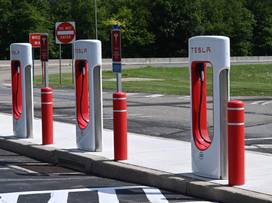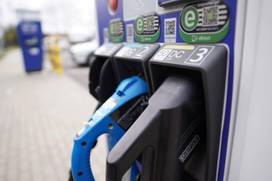Electric vehicle (EV) charging is expected to present a huge business opportunity in the coming years, with the global EV charging station market projected to reach a value of $823 billion by 2028. Even though the market is still fragmented and undeveloped, it’s not too early for companies to start positioning themselves to compete in it. But those interested in capitalizing on this growing demand should understand that delivering these services will likely require new business models—and start preparing accordingly.
Read on to find answers to your most pressing questions about the business potential of commercial EV charging—from startup costs and revenue models to monetization strategies and tips on how to make your emerging EV charging business as profitable as possible.
Rising demand and the role of public EV charging
Thanks to factors such as falling costs, widening availability, and support from public policymakers, global electric car sales continued their strong growth in 2022 after breaking records last year. And the pace of development shows no signs of slowing down; in their 2022 Electric Vehicle Outlook, Bloomberg estimates there will be 77 million passenger EVs on the road by 2025.
However, the growing number of EVs on the road is at odds with the gaps in the charging infrastructure necessary to support these vehicles. According to a 2022 analysis of U.S. charging infrastructure by McKinsey, the country will need almost 20 times more chargers than it has now if it succeeds in meeting its 2030 federal EV sales targets. While many of these chargers would be installed at residences, the analysis also estimates the need for around 1.2 million public chargers.
Installed at on-the-go locations and at destinations where vehicles are parked for long periods, public chargers have an important role to play in covering the remaining needs of EV owners. And as the price of EVs drops and they begin to penetrate new markets, particularly middle- and lower-income households without access to home-charging options, the role of public charging will likely become more crucial.
Commercial EV charging stations: FAQs on the business of EV charging
Commercial property owners have the opportunity to play an important part in expanding access to public EV charging infrastructure. But of course, as a business owner, you’re probably wondering about the profit potential of a commercial EV charging business, as well as the associated costs.
Who can install commercial EV charging stations?
EV owners need options for charging their vehicles away from home, and business owners are in a perfect position to provide charging space and options. But what kinds of businesses and commercial properties are best suited for installing and hosting public EV charging stations?
A few examples of ideal commercial prospects include:
- Multifamily living spaces: In many urban centers, commercial EV charging stations are a must when it comes to attracting tenants, residents, and visitors. Installing EV chargers at apartment buildings, condos, and other multifamily buildings can increase property value and draw in new prospective clients.
- Workplaces: Since people park their vehicles at work more often than almost anywhere else outside of the home, offering a charging station can be a great way to attract EV drivers as employees. According to a survey from the U.S. Department of Energy, 80% of employers with an on-site EV charging station say that it has helped them attract and retain more top talent.
- Retail districts and shopping centers: Most EV owners want to be able to charge their cars somewhere convenient—somewhere they can park and plug their vehicle in to charge while they’re off enjoying themselves or running necessary errands. Shopping centers, restaurants, business districts, and malls can install EV chargers to attract these types of shoppers.
Service locations: Hospitals, universities, and public buildings often have sustainability goals they’re working towards and installing an EV charger can help them get LEED credits or government funding. These locations also typically have a large employee workforce, and as previously mentioned, EV chargers are an environmentally-friendly way to attract more talent.
How much does a commercial EV charging station cost??
The cost of installing a commercial electric vehicle charging station will vary greatly depending on factors such as the type of charger, the number of chargers, and whether you want any additional features. But the first and most important thing to consider when estimating costs is the level of EV charger(s) that will be installed.
Basically, the higher the level of charging, the faster the charging process. It’s important to note that different EVs charge at different speeds on each level since each EV battery can accept different levels of power from the charger. Because public chargers tend to be used for shorter periods of time, as opposed to home charging, where EV owners typically leave their vehicles to charge overnight, most commercial facilities use Level 2 or DC fast chargers.
Here’s a quick breakdown of the different types of EV chargers and their associated equipment costs:
- Level 1 charging stations require a 120-volt, single-phase AC power outlet similar to those you have in your home. They’re the cheapest option, at a price range of $300 to $1,500, but they’re also the least powerful, and are generally not adequate for commercial charging enterprises.
- Level 2 EV chargers also use single-phase AC power outlets but they’re much faster and more powerful, packing 208 to 240 volts and with a power rating that ranges from 3kW to a little over 20kW. Depending on the specific model, you can expect to pay between $400 and $6,500 for a level 2 commercial EV charger.
- Lever 3 electric charging stations, i.e. DC fast chargers (DCFC), are the fastest commercial charging option. They use a 480 to 600-volt input with a power rating between 25kW and 50kW. The hardware cost for a DC fast charger ranges from $10,000 up to $40,000.
Of course, there are many other factors to consider when budgeting for an EV charging station. The final budget will increase further after considering additional required expenses related to:
Infrastructure
Infrastructure is a defining factor in final cost since each level of charger requires a dedicated infrastructure to provide the right voltage and power output. This infrastructure will likely include components such as a feeder and cable pole, a high amp circuit breaker, a power protection system, proper wiring, and installation labour.
Depending on your particular installation requirements, these infrastructure costs can range from $200 to $1,500 for Level 1/2 chargers, or up to $40,000 for Level 3/DCFCs.
Soft costs
The term “soft costs” used for commercial EV charging stations typically refers to all of the necessary permits required for setup as well as any other expenses required to make the place suitable for a business. This can include charging parking ports, charger logos, signalization, protective bollards, and other such costs.
As a general rule, you should expect soft costs to account for about 5% of your overall EV station costs.
Software
Utility companies require that commercial EV charging stations have network subscriptions installed as well as net metering system software that provides monitoring, protection, and data analysis.
Software expenses for commercial electric car charging stations typically amount to a little less than $300 per year.
What are commercial EV charging business models?
Commercial EV charging stations typically use one of two EV charging business models: the property owners are either owner-operators, which means they own the equipment and are responsible for all of the costs outlined above, including installation and ongoing maintenance costs, or they contract their property’s EV charging services out to a third-party service supplier, in which case they simply pay a recurring monthly service fee.
There are pros and cons to each of these business models, and the right choice for your commercial site will depend on a number of factors such as your site location(s), your total number of sites, and how you intend the EV charging infrastructure to be used. The main thing you should know is that being an owner-operator requires more up-front investment and financial responsibility over the long term, but it also gives you complete control over the pricing structure and customer experience. Essentially, a setup where you yourself are the owner-operator comes with some associated financial risks, but it also offers a higher profit potential.
How do EV charging stations make money?
Installing public EV charging stations at a commercial property is a great way to attract new tenants, residents, and customers and can help boost on-site sales by increasing their average dwell time. As an added bonus, these chargers can generate direct revenue for the property. But just how much revenue do they generate? And can commercial property owners truly expect to drive significant revenue by installing EV charging stations?
The short answer is: it depends. The amount of control you’ll have as a commercial property owner will be dictated by your chosen business model, but when it comes to generating revenue directly from the chargers themselves, there are currently two main options:
- Usage fees: Drivers pay a subscription or fee for EV charging. This typically entails charging for the amount of energy being used or the amount of time spent plugged into a charger, with some sites offering a combination of the two charging forms as a way to reduce the hourly rate while still ensuring don’t “camp out” in a spot once their vehicle is already fully charged.
- Place-based advertising: Chargers connected to digital screens generate revenue through the sale of digital out-of-home (DOOH) ad placements. These placements can be sold to advertisers directly according to a set frequency, location, or specific time slot, or they can be sold programmatically according to specific audience targeting and campaign goals. Check out our guide to EV place-based advertising to learn more about EV charging stations connected to digital signage.
While user fees are an effective tool to offset the operational costs of your EV charging stations, implementing a fee structure designed to turn a profit from the sale of charging services alone can ultimately end up backfiring—especially since many EV owners can charge their vehicles at home at very little cost. Depending on how you intend for your charging infrastructure to be used, your business might benefit more from a fee structure that ensures a high rate of utilization and encourages longer customer dwell time.
When you look at commercial EV charging as a form of advertising, though, everything changes. In fact, advertising revenue has been shown to have the single largest impact on EV charging station profitability. The revenue your business can earn from ad sales will depend on your chargers’ screen placement, location, and potential audience, but DOOH-enabled chargers set up in busy, high-traffic areas will be extremely attractive to brand advertisers looking for new ways to connect with their customers—meaning they’ll have an extremely high profit potential. Moreover, adding digital signage to your EV charging stations doesn’t mean choosing one revenue model over the other; you could feasibly charge a nominal user fee to offset your operating costs and also leverage digital place-based ad placements to generate an entirely new revenue stream.









